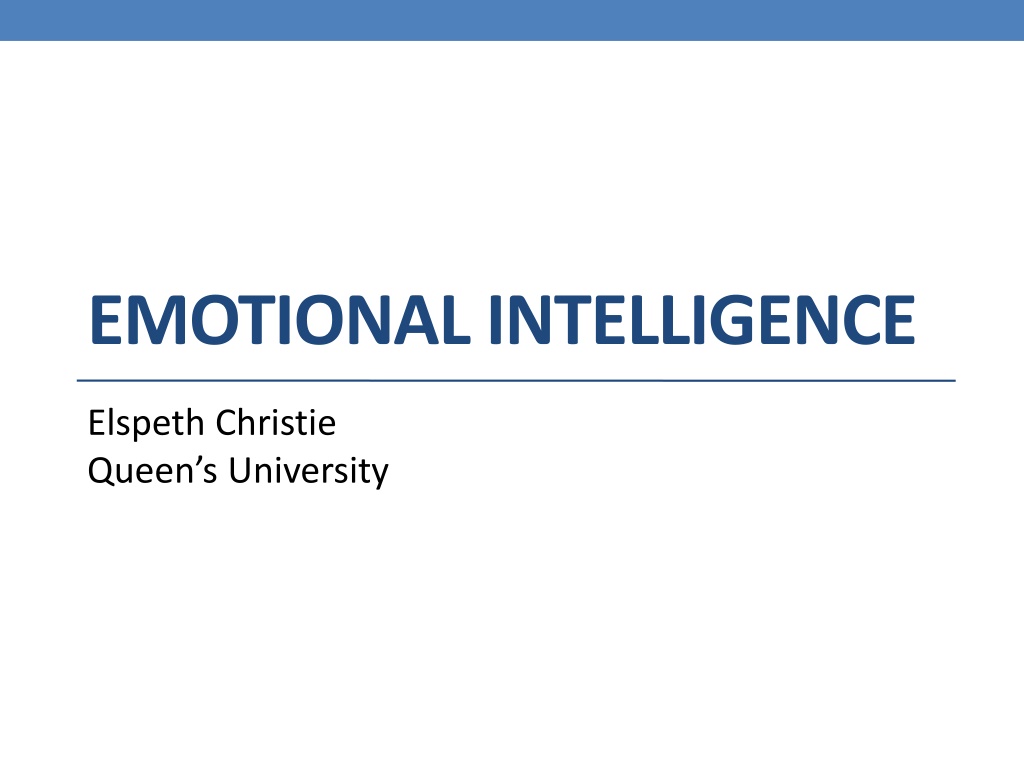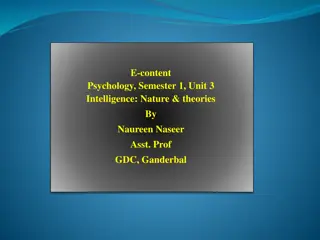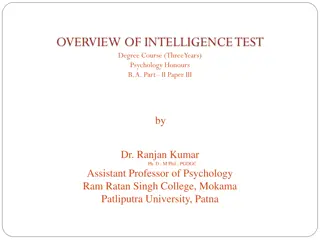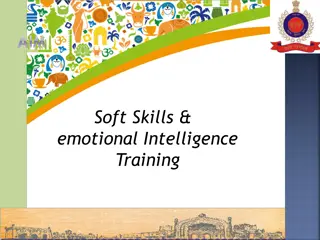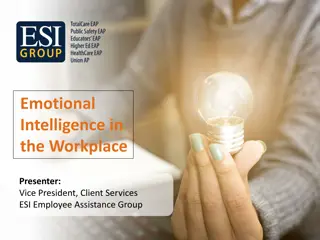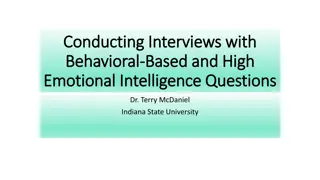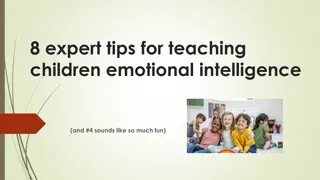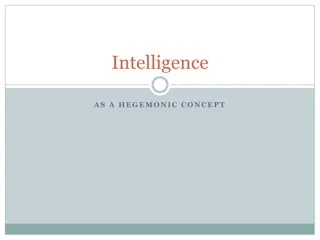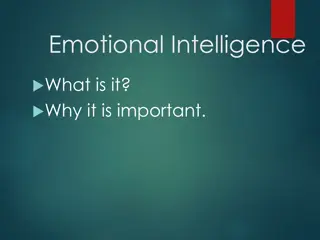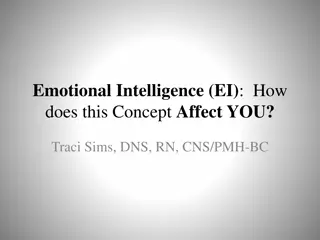Emotional Intelligence and its Components
Emotional Intelligence is about identifying, understanding, and managing emotions, recognizing your own needs and those of others, and enhancing interpersonal skills. It involves self-perception, self-expression, and affects decision-making and stress management. People with high emotional intelligence exhibit traits like self-reflection, intuition, and assertiveness, leading to better relationships and decision-making. Research findings show gender differences in aspects like self-regard and empathy, while Emotional Intelligence peaks at a certain age according to the Bar-On model.
Download Presentation

Please find below an Image/Link to download the presentation.
The content on the website is provided AS IS for your information and personal use only. It may not be sold, licensed, or shared on other websites without obtaining consent from the author. Download presentation by click this link. If you encounter any issues during the download, it is possible that the publisher has removed the file from their server.
E N D
Presentation Transcript
EMOTIONAL INTELLIGENCE Elspeth Christie Queen s University
Emotional Intelligence isnt: Charisma Being nice Personality Fixed from birth The latest self-improvement fad
Emotional Intelligence is: Identifying, understanding, and managing your emotions Recognizing and managing your own needs Recognizing and relating to the needs of others Subject to change with circumstances and age A skill that can be enhanced
Emotional Intelligence Starts with self-perception and self-awareness Manifests in self-expression Shows up in all relationships Affects decision-making Enables stress management
People with high emotional intelligence (continued): Trust their intuition Label and predict their feelings Self-reflect Know their values and goals Openly receive feedback and are interested in self-improvement
People with high emotional intelligence: Take responsibility for their feelings Validate other people s feelings Consider their feelings when making decisions Have a sense of humour about themselves Are assertive, not aggressive or passive-aggressive Are active listeners
Interesting research findings Men have higher self-regard scores Men have higher stress tolerance scores Women have higher empathy scores Women have higher social responsibility scores EI peaks at what age? Source: Bar-On, R. (2006). The Bar-On model of emotional-social intelligence (ESI). Psicothema, 18 , supl., 13-25.
Homework Review EI Components 1 Self-regard Self-actualization Emotional self-awareness SELF-PERCEPTION Based on the EQ-i 2.0 Model. Source: Multi-Health Systems Inc. (March 2011). The complete EQ-I 2.0 experience. Retrieved from http://downloads.mhs.com/eqi/EQi-Launch-Kit.pdf
HomeworkReview EI Components 2 Emotional expression Assertiveness Independence SELF-EXPRESSION Based on the EQ-i 2.0 Model. Source: Multi-Health Systems Inc. (March 2011). The complete EQ-I 2.0 experience. Retrieved from http://downloads.mhs.com/eqi/EQi-Launch-Kit.pdf
HomeworkReview EI Components 3 Interpersonal relationships Empathy Social responsibility INTERPERSONAL Based on the EQ-i 2.0 Model. Source: Multi-Health Systems Inc. (March 2011). The complete EQ-I 2.0 experience. Retrieved from http://downloads.mhs.com/eqi/EQi-Launch-Kit.pdf
HomeworkReview EI Components 4 Problem-solving Reality testing Impulse control DECISION-MAKING Based on the EQ-i 2.0 Model. Source: Multi-Health Systems Inc. (March 2011). The complete EQ-I 2.0 experience. Retrieved from http://downloads.mhs.com/eqi/EQi-Launch-Kit.pdf
Homework Review EI Components 5 Flexibility Stress tolerance Optimism STRESS MANAGEMENT Based on the EQ-i 2.0 Model. Source: Multi-Health Systems Inc. (March 2011). The complete EQ-I 2.0 experience. Retrieved from http://downloads.mhs.com/eqi/EQi-Launch-Kit.pdf
Quiz Time! Emotional Intelligence Competencies Matching Game
Applying and Practicing Emotional Intelligence Case Study: Jamie Jamie is experiencing conflict with her housemates. Jamie is in Nursing and has a very intense schedule this semester. On top of classes, she has a 12-hour clinical placement shift each Thursday at a hospital that is 45 minutes away. She has a merit-based scholarship and needs to maintain a high GPA each semester to keep it. Jamie and her housemates, Lynn and Anjali, became friends in first year when they lived in residence together. Lynn and Anjali are both in social sciences programs and have more open schedules than Jamie. They also like to party a lot. Jamie hit a breaking point this week when Lynn and Anjali threw a party on Wednesday night, without telling her first. The party was so loud that Jamie couldn t sleep. She woke up at 6 a.m. for her clinical placement feeling exhausted.
Applying and Practicing Emotional Intelligence Case Study: Jamie Continued How could Jamie respond? Which responses show high emotional intelligence? Which responses show low emotional intelligence? Which competency area(s) relate to each response?
Applying and Practicing Emotional Intelligence Case Study: Ling Small group activity Review the case study about Ling Discuss the following questions with your group: What might someone with high EI say, think, or do? What might someone with low EI say, think, or do? Look at the emotional intelligence competency areas for ideas.
Application to Peer Mentoring How is emotional intelligence relevant and applicable to your role as a Peer Mentor? Choose three of the EI components that you think will be the most valuable and/or effective in your role as a Peer Mentor.
Techniques for Increasing Your EI Gratitude Seek and accept feedback Vulnerability Listen to yourself Best friend Practice
EI Self-Assessment Looking at your self-assessment 1. What is one strategy you will practice to further enhance your strongest EI domain? 2. What is one strategy you will practice to develop a weaker EI domain?
